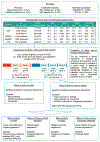Effect Sizes of Deletions and Duplications on Autism Risk Across the Genome
- PMID: 32911998
- PMCID: PMC8931740
- DOI: 10.1176/appi.ajp.2020.19080834
Effect Sizes of Deletions and Duplications on Autism Risk Across the Genome
Abstract
Objective: Deleterious copy number variants (CNVs) are identified in up to 20% of individuals with autism. However, levels of autism risk conferred by most rare CNVs remain unknown. The authors recently developed statistical models to estimate the effect size on IQ of all CNVs, including undocumented ones. In this study, the authors extended this model to autism susceptibility.
Methods: The authors identified CNVs in two autism populations (Simons Simplex Collection and MSSNG) and two unselected populations (IMAGEN and Saguenay Youth Study). Statistical models were used to test nine quantitative variables associated with genes encompassed in CNVs to explain their effects on IQ, autism susceptibility, and behavioral domains.
Results: The "probability of being loss-of-function intolerant" (pLI) best explains the effect of CNVs on IQ and autism risk. Deleting 1 point of pLI decreases IQ by 2.6 points in autism and unselected populations. The effect of duplications on IQ is threefold smaller. Autism susceptibility increases when deleting or duplicating any point of pLI. This is true for individuals with high or low IQ and after removing de novo and known recurrent neuropsychiatric CNVs. When CNV effects on IQ are accounted for, autism susceptibility remains mostly unchanged for duplications but decreases for deletions. Model estimates for autism risk overlap with previously published observations. Deletions and duplications differentially affect social communication, behavior, and phonological memory, whereas both equally affect motor skills.
Conclusions: Autism risk conferred by duplications is less influenced by IQ compared with deletions. The model applied in this study, trained on CNVs encompassing >4,500 genes, suggests highly polygenic properties of gene dosage with respect to autism risk and IQ loss. These models will help to interpret CNVs identified in the clinic.
Keywords: Autism Spectrum Disorder; Copy Number Variants; IQ.
Figures




Similar articles
-
Measuring and Estimating the Effect Sizes of Copy Number Variants on General Intelligence in Community-Based Samples.JAMA Psychiatry. 2018 May 1;75(5):447-457. doi: 10.1001/jamapsychiatry.2018.0039. JAMA Psychiatry. 2018. PMID: 29562078 Free PMC article.
-
Association of copy number variation across the genome with neuropsychiatric traits in the general population.Am J Med Genet B Neuropsychiatr Genet. 2018 Jul;177(5):489-502. doi: 10.1002/ajmg.b.32637. Epub 2018 Apr 24. Am J Med Genet B Neuropsychiatr Genet. 2018. PMID: 29687944 Free PMC article.
-
Refinement and discovery of new hotspots of copy-number variation associated with autism spectrum disorder.Am J Hum Genet. 2013 Feb 7;92(2):221-37. doi: 10.1016/j.ajhg.2012.12.016. Epub 2013 Jan 31. Am J Hum Genet. 2013. PMID: 23375656 Free PMC article.
-
Duplication Versus Deletion Through the Lens of 15q13.3: Clinical and Research Implications of Studying Copy Number Variants Associated with Neuropsychiatric Disorders in Induced Pluripotent Stem Cell-Derived Neurons.Stem Cell Rev Rep. 2023 Apr;19(3):639-650. doi: 10.1007/s12015-022-10475-0. Epub 2022 Nov 12. Stem Cell Rev Rep. 2023. PMID: 36370261 Free PMC article. Review.
-
The genetics of autism.Pediatrics. 2004 May;113(5):e472-86. doi: 10.1542/peds.113.5.e472. Pediatrics. 2004. PMID: 15121991 Review.
Cited by
-
The contribution of copy number variants to psychiatric symptoms and cognitive ability.Mol Psychiatry. 2023 Apr;28(4):1480-1493. doi: 10.1038/s41380-023-01978-4. Epub 2023 Feb 3. Mol Psychiatry. 2023. PMID: 36737482 Free PMC article. Review.
-
Copy Number Variant Risk Scores Associated With Cognition, Psychopathology, and Brain Structure in Youths in the Philadelphia Neurodevelopmental Cohort.JAMA Psychiatry. 2022 Jul 1;79(7):699-709. doi: 10.1001/jamapsychiatry.2022.1017. JAMA Psychiatry. 2022. PMID: 35544191 Free PMC article.
-
Integrative genetic analysis: cornerstone of precision psychiatry.Mol Psychiatry. 2025 Jan;30(1):229-236. doi: 10.1038/s41380-024-02706-2. Epub 2024 Aug 30. Mol Psychiatry. 2025. PMID: 39215185 Review.
-
Genome-wide rare variant score associates with morphological subtypes of autism spectrum disorder.Nat Commun. 2022 Oct 29;13(1):6463. doi: 10.1038/s41467-022-34112-z. Nat Commun. 2022. PMID: 36309498 Free PMC article.
-
Subcortical Brain Alterations in Carriers of Genomic Copy Number Variants.Am J Psychiatry. 2023 Sep 1;180(9):685-698. doi: 10.1176/appi.ajp.20220304. Epub 2023 Jul 12. Am J Psychiatry. 2023. PMID: 37434504 Free PMC article.
References
-
- American Psychiatric Association: Diagnostic and Statistical Manual of Mental Disorders (DSM-5®). American Psychiatric Pub, 2013
-
- Simonoff E, Pickles A, Charman T, et al.: Psychiatric disorders in children with autism spectrum disorders: prevalence, comorbidity, and associated factors in a population-derived sample. J Am Acad Child Adolesc Psychiatry 2008; 47:921–929 - PubMed
Publication types
MeSH terms
Grants and funding
LinkOut - more resources
Full Text Sources
Other Literature Sources
Miscellaneous

